Interesting Facts About Iodine You Never Knew
Did you know that iodine was accidentally discovered while processing seaweed? This element, named after its violet vapor, is essential for your thyroid function and overall health. It's so important that iodized salt was introduced to combat deficiencies. Iodine's unique properties include sublimation at room temperature and forming yellow solutions in organic solvents. Beyond nutrition, it's used in photography, medical imaging, and as a disinfectant. Surprisingly, about 2 billion people worldwide lack sufficient iodine intake, leading to health issues. The more you explore this element's characteristics and applications, the more intriguing facts you'll uncover about its impact on daily life and technology.
This post may contain affiliate links. If you make a purchase through these links, I may earn a commission at no additional cost to you. Additionally, portions of this post may be generated using artificial intelligence (AI) technology. While we strive for accuracy, please be aware that AI-generated content may not always be perfect and should be fact-checked when necessary.
The Spatula Scoops
- Iodine sublimes directly into violet vapor at room temperature, bypassing the liquid phase.
- Approximately 2 billion people worldwide experience iodine deficiency, leading to intellectual disabilities.
- Iodine was first used in photography in 1839 during the daguerreotype process.
- Iodine-131 is essential for diagnosing and treating thyroid conditions.
- The term "iode" comes from the Greek word meaning "violet," referencing the gas's color.
The Purple Gas Discovery
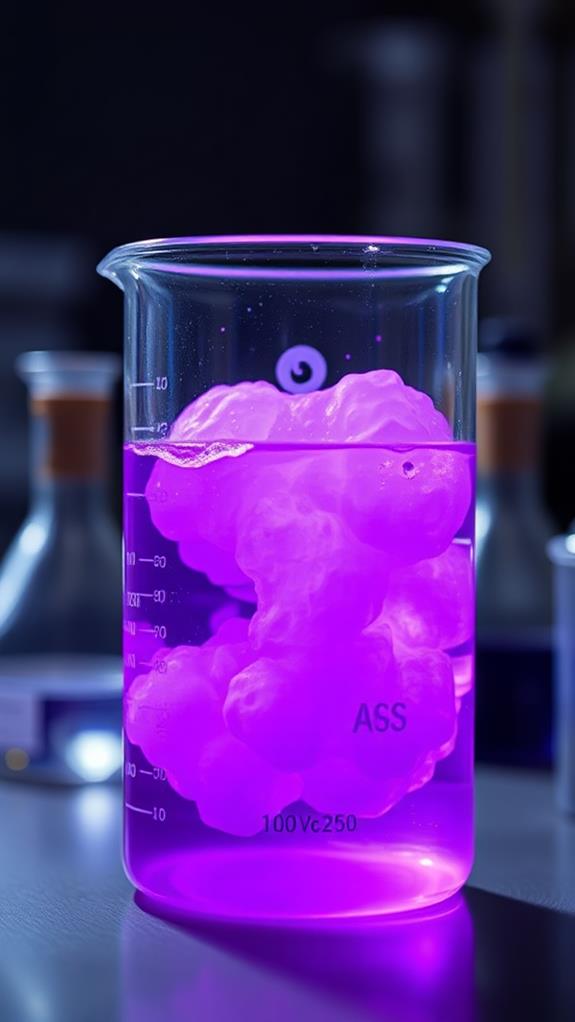
In 1811, Bernard Courtois stumbled upon a remarkable discovery while processing seaweed. As he worked to extract potassium chloride, an unexpected violet gas suddenly emerged, catching his attention. This vibrant purple gas would soon be identified as iodine vapors, marking a significant moment in scientific history.
You might wonder how this accidental finding got its name. The term "iode," meaning violet in Greek, was chosen due to the distinctive color of the gas. As Courtois continued his work, he managed to condense the purple gas into dark, solid iodine crystals. This unique transformation from gas to solid further distinguished iodine from other known elements at the time.
The discovery of iodine and its eye-catching purple fumes quickly captured the interest of chemists worldwide. Its unique properties opened up new possibilities in various fields. You'll find that iodine's early applications extended to both photography and medicine, paving the way for numerous advancements. Courtois' accidental discovery during seaweed processing ultimately led to a significant contribution to science, demonstrating how unexpected observations can lead to groundbreaking findings.
From Seaweed to Saltshakers
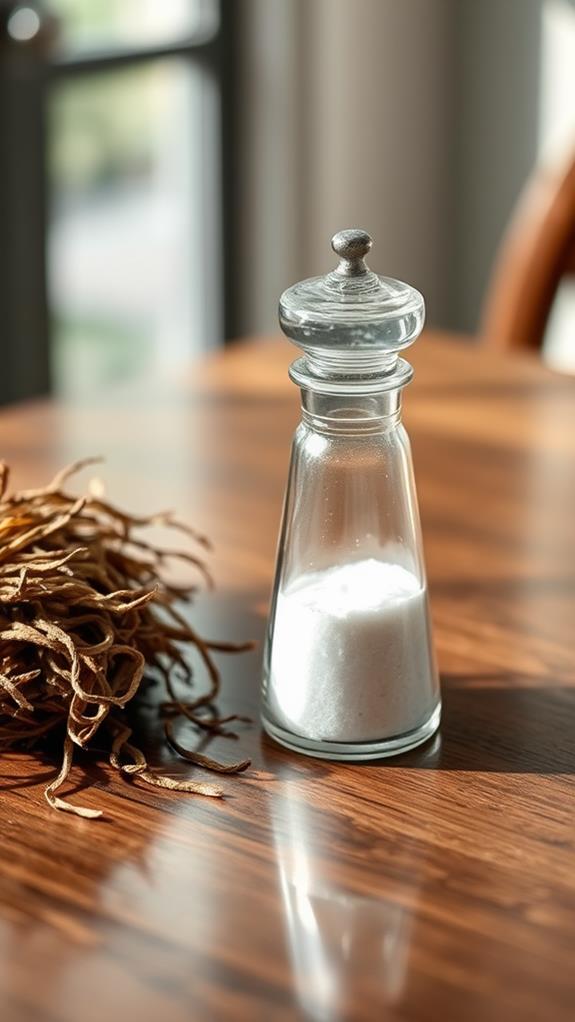
Seaweed's role in iodine's story didn't end with Courtois' discovery. In fact, it's still a major player in our iodine intake today. You might be surprised to learn that the largest natural reservoir of iodine is seawater, containing a staggering 34.5 million tons. However, its concentration is quite low at 50-60 ppb.
To combat iodine deficiency and prevent goiter, a public health initiative introduced iodized salt in the U.S. in 1924. This addition of potassium iodide to table salt has been essential in maintaining adequate iodine levels in our diets. You'll find iodine in various dietary sources, with seafood, dairy products, and eggs being primary contributors. Seaweed, unsurprisingly, tops the list as one of the richest sources.
It's important to note that not all salts are created equal when it comes to iodine content. Non-iodized specialty salts like sea salt and kosher salt often lack sufficient iodine. So, if you're using these in your cooking, you'll need to verify you're getting enough iodine from other sources to maintain ideal health.
Thyroid's Essential Element
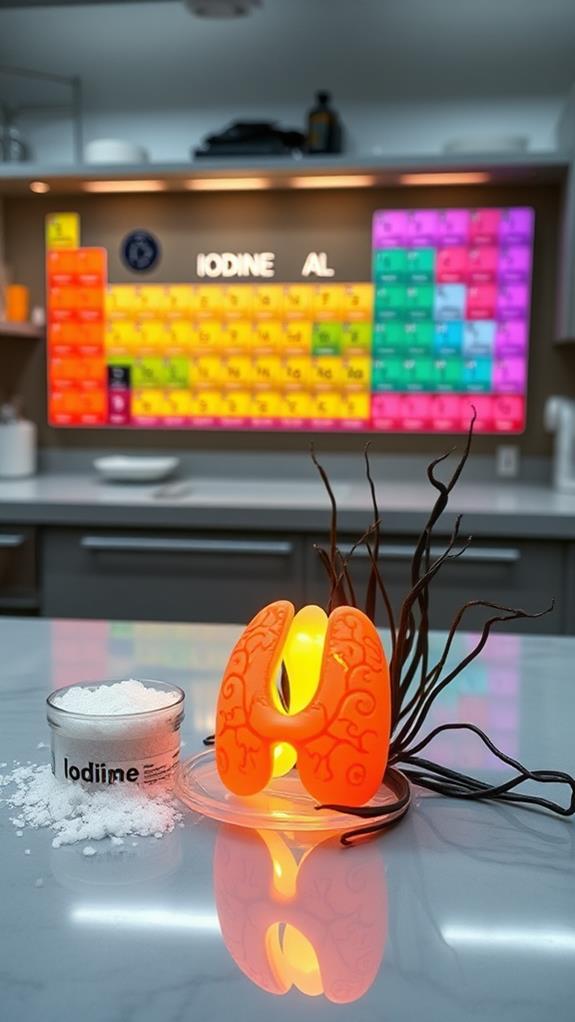
You might be surprised to learn that iodine plays a starring role in your thyroid's hormone production. This essential element acts as a catalyst, enabling your thyroid to create T3 and T4 hormones, which regulate your metabolism and growth. By ensuring you get enough iodine in your diet, you're not just supporting your thyroid's function; you're also guarding against goiter, a condition where your thyroid gland becomes enlarged due to iodine deficiency.
Hormone Production Catalyst
At the heart of thyroid function lies iodine, an essential trace element that serves as the catalyst for hormone production. You might not realize it, but this mineral plays a significant role in synthesizing thyroid hormones T4 and T3, which regulate your metabolism and overall body function. Each T4 molecule contains four iodine atoms, while T3 has three, highlighting iodine's direct impact on these hormones' structure.
To maintain ideal thyroid health, you need to meet the Recommended Dietary Allowance (RDA) for iodine, which is about 150 mcg for adults. If you're pregnant, you'll need even more – 220 mcg – to support fetal development. Iodine deficiency can lead to serious health issues, including goiter and cognitive impairments in children. In fact, it's a leading preventable cause of intellectual disabilities worldwide.
Your thyroid gland relies on thyroid-stimulating hormone (TSH) to regulate iodine uptake. When iodine levels are low, TSH levels rise, causing your thyroid to enlarge in an attempt to capture more iodine. This is why iodized salt and other iodine-rich foods are essential for maintaining thyroid health and preventing deficiency-related complications.
Goiter Prevention Powerhouse
As a goiter prevention powerhouse, iodine stands out as the thyroid's essential element. You might not realize it, but this trace mineral plays a vital role in your health by supporting hormone production and preventing thyroid enlargement. Iodine deficiency affects nearly 2 billion people worldwide, making it a significant global health concern.
To combat this issue, many countries have implemented iodination strategies, with iodized salt being the most common method. Here's why iodine is so important for your thyroid health:
- It's necessary for synthesizing thyroid hormones T3 and T4
- It regulates your metabolism and overall development
- It prevents goiter, an enlarged thyroid gland that can disrupt hormone production
You can guarantee adequate iodine intake by consuming the recommended daily amount. The World Health Organization suggests 150 mcg for adults and 250 mcg for pregnant women. By incorporating iodized salt and iodine-rich foods into your diet, you're taking a proactive step in goiter prevention and supporting your overall thyroid function. Remember, a little iodine goes a long way in maintaining your health and well-being.
Iodine's Global Health Impact

Despite its tiny presence in our bodies, iodine plays an outsized role in global health. You might be surprised to learn that iodine deficiency affects about 2 billion people worldwide, making it the leading preventable cause of intellectual disabilities in developing regions. That's why health organizations like the World Health Organization have been advocating for iodized salt programs in over 130 countries.
These initiatives aim to guarantee adequate iodine intake for vulnerable populations, particularly pregnant women. Did you know that expectant mothers need 300 mcg of iodine daily to support fetal development? It's vital for producing thyroid hormones, which are essential for growth and brain development.
Monitoring iodine status is key to preventing issues like goiter, a condition that was once common in the U.S. "goiter belt." Health experts use urinary iodine concentration to assess population health, with levels below 100 mcg/L indicating inadequate intake. By implementing iodization programs and educating people about proper iodine intake, we're making significant strides in global health. It's a small element with a big impact on our well-being.
Peculiar Properties of Element 53
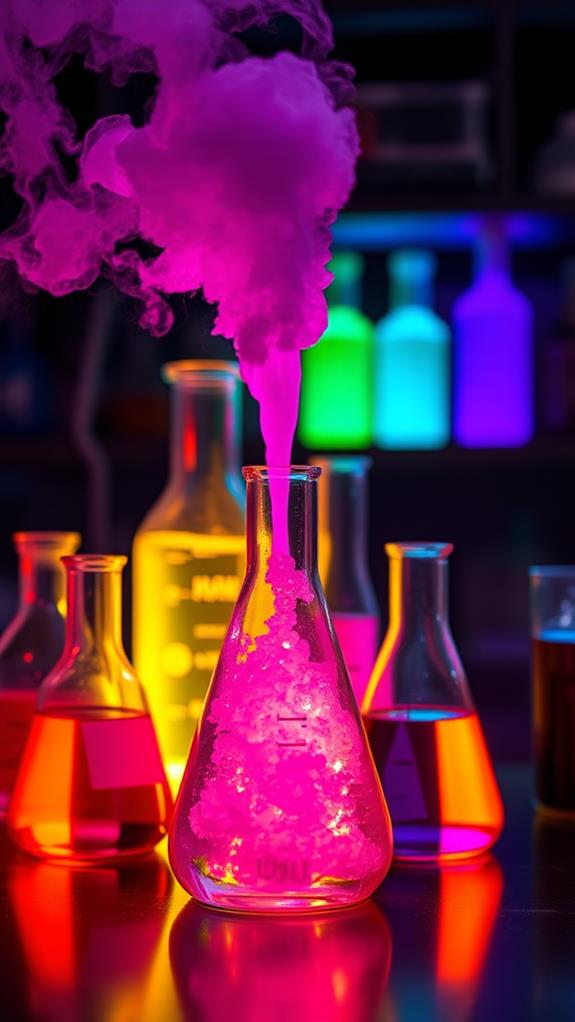
While many elements on the periodic table might seem unremarkable, iodine stands out with its striking features. This element, with atomic number 53, boasts a unique bluish-black appearance as a solid. But that's not all—it sublimates directly into a violet vapor at room temperature, skipping the liquid phase entirely.
Iodine's peculiar properties don't stop there. Here are three more fascinating facts:
- It has a high density of 4.93 grams per cubic centimeter, making it surprisingly heavy for its size.
- Its electron configuration ([Kr] 4d10 5s2 5p5) gives it some metallic properties, setting it apart from other halogens.
- While poorly soluble in water, it forms yellow-colored solutions in organic solvents like chloroform.
You'll find that iodine is less reactive than its halogen siblings, behaving more like a metal in some ways. It's a chameleon of sorts, changing colors depending on its environment. In organic solvents, you'll see a vivid purple hue. This element's unique characteristics make it an intriguing subject for chemists and a valuable component in various compounds and applications.
Are There Any Connections Between Iodine and Mushrooms?
Iodine and mushrooms may not seem connected at first glance, but certain mushroom species can accumulate iodine from their environment. Exploring this link reveals mindblowing facts about fascinating mushroom species, showcasing their unique ability to absorb and transform diverse nutrients, offering potential health benefits and environmental insights worth investigating further.
Beyond Nutrition: Iodine Applications
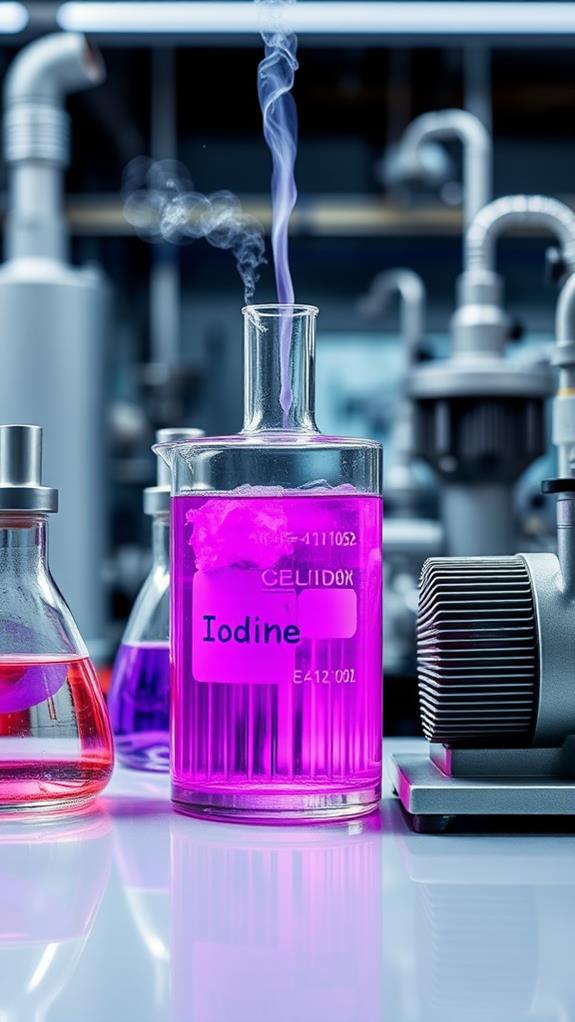
You might be surprised to learn that iodine's uses extend far beyond the dinner table. In industry, it's a versatile player, serving as a catalyst in chemical reactions and finding its way into animal feed for healthier livestock. You'll find iodine's fingerprints in unexpected places, from the silver iodide used in traditional photography to the iodinated contrast media that make medical imaging possible, not to mention its role as a potent antiseptic in hospitals and for wound care.
Industrial Uses of Iodine
Beyond its nutritional importance, iodine boasts a wide range of industrial applications. You'll find this essential element in various sectors, from medicine to photography. Iodine compounds, particularly iodinated contrast agents, play a significant role in medical imaging. These agents enhance the visibility of internal structures during X-rays and CT scans, allowing for more accurate diagnoses.
In the world of photography, you might be surprised to learn that silver iodide is a key component in traditional film emulsions. This iodine compound helps capture those precious moments on celluloid.
Iodine's versatility extends to other industrial processes as well. Here are three notable uses:
- Potassium iodide (KI) serves as an effective disinfectant for wounds and water supplies, thanks to its antimicrobial properties.
- Iodine is added to animal feed supplements to promote growth and health in livestock, supporting thyroid function.
- Various chemical reactions in industrial settings rely on iodine-based catalysts, showcasing its importance beyond nutrition.
These applications demonstrate how iodine's unique properties make it an indispensable element in numerous industries, far beyond its well-known role in our diets.
Iodine in Photography
Though often overlooked, iodine's role in photography has been vital since the early days of the medium. You might be surprised to learn that iodine was first used in photography back in 1839 during the daguerreotype process. This groundbreaking technique involved creating light-sensitive plates using silver iodide, which could capture images when exposed to light.
The process was intricate: a treated silver plate was exposed to light, forming an image that was then developed using iodine vapors. Iodine's ability to form a stable compound with silver made it essential for early photographic materials, greatly enhancing image clarity and contrast.
As you explore the history of photography, you'll find that iodine played a vital role in laying the foundation for modern imaging technology. While advancements in digital technology have largely replaced iodine-based processes in commercial photography, its historical significance can't be overstated. Today, iodine isn't commonly used in photography, but its unique properties paved the way for the digital imaging revolution you're familiar with. Understanding this history gives you insight into the evolution of the photographic techniques we now take for granted.
Medical Applications
Numerous medical applications showcase iodine's versatility beyond its nutritional role. You'll find iodine-based solutions, like potassium iodide, widely used as a disinfectant for external wounds. This element's antiseptic properties make it invaluable for skin sterilization before surgeries, enhancing infection control and patient safety.
In nuclear medicine, iodine-131 plays an essential role in diagnosing and treating thyroid conditions. It's particularly effective for:
- Hyperthyroidism management
- Thyroid cancer treatment
- Thyroid gland imaging
You might not realize it, but iodine is also essential in various imaging procedures. Iodinated contrast media help enhance visibility during X-rays and CT scans, allowing for better visualization of internal structures. This improved imaging capability aids in more accurate diagnoses and treatment planning.
The medical applications of iodine extend far beyond what you might expect from this element. From its use as a potent disinfectant to its role in advanced imaging techniques, iodine continues to be a cornerstone in modern medicine. Its ability to aid in both diagnosis and treatment of various conditions, particularly those related to the thyroid, makes it an indispensable tool in healthcare.
Frequently Asked Questions
What You Didn T Know About Iodine?
You might not know that iodine's discovery was accidental, resulting from seaweed processing. It's abundant in seawater but at low concentrations. Iodine is essential for fetal development and thyroid function, with pregnant women needing about 300 mcg daily. Surprisingly, iodine deficiency affects around 2 billion people globally. Iodized salt, introduced in the U.S. in 1924, has become a widespread public health strategy, greatly reducing goiter prevalence in over 130 countries. This simple addition has prevented countless cases of intellectual disability.
What Are the Unusual Properties of Iodine?
You'll find iodine's properties quite unusual. It's a solid that sublimes into a vibrant violet gas when heated, skipping the liquid phase. You'll notice it's only slightly soluble in water, forming a yellow solution, but it dissolves readily in organic solvents, creating a striking purple color. Iodine's metallic properties are unexpected for a halogen, as it can form crystalline structures when solidified. It's also less reactive than its halogen siblings, setting it apart in the group.
What Is a Fun Fact About Iodine-131?
Did you know that iodine-131 emits 971,000 beta particles per second? Here's a fun fact: You'd be surprised to learn that this radioactive isotope can be your thyroid's best friend or worst enemy. It's used to diagnose and treat thyroid disorders, but it's also a byproduct of nuclear accidents. Curiously, after the Chernobyl disaster, people were advised to take potassium iodide tablets to prevent their thyroids from absorbing the harmful iodine-131 released into the environment.
How Did Iodine Get Its Name?
You'll find the origin of iodine's name in its distinctive appearance. When Bernard Courtois discovered it in 1811, he observed purple fumes and dark crystals. This striking violet color inspired its name, derived from the Greek word "iodes," meaning violet. Joseph Louis Gay-Lussac, who further studied the element, recognized its unique properties and helped establish its identity. The name "iodine" has stuck ever since, reflecting the element's most noticeable characteristic when it's in its gaseous state.





